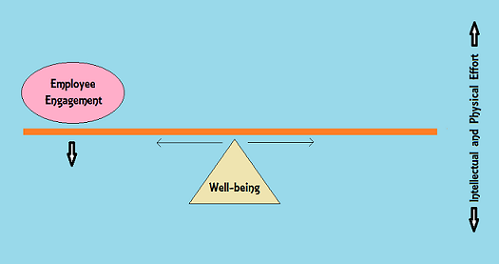At HC, we believe that employee engagement is the single most important people-related variable in the workplace. Employee engagement is primarily an emotional construct which leads to increased discretionary effort both intellectually and physically and is likely to lead to a range of positive outcomes, many of which can be measured and have clear bottom-line impacts (such as reduced turn-over and absenteeism).
If we accept the premise that employee engagement is essentially an emotional phenomena, it makes sense that an employee’s general emotional state is likely to impact on both their level of engagement in the workplace AND the way that this level of engagement translates into discretionary effort. Put simply, if you are feeling depressed or anxious (even if the cause of this has nothing to do with work), you will be less likely to be 100% engaged at work.
The relationship between employee well-being, engagement at work and the way that this impacts on an employee’s effort in the workplace is relatively complex. An individual’s level of engagement is shaped by a clear sense of purpose, autonomy and the extent to which they are being challenged and learning new things at work. In other words, each of those three key drivers is independent of an employee’s general level of well-being. However, if an employee is anxious or depressed, because of some personal matters outside of work, this is almost definitely going to impact on the level of discretionary effort that they exercise at work.
We believe that the nature of the relationship between well-being and engagement is best described using a see-saw analogy. We all know that the greater an employee’s engagement, the greater the level of discretionary effort an employee is likely to exercise. In terms of a see-saw, if a great big dose of engagement sits one end of the see-saw, the other end is likely to go up. We think that employee well-being is like the fulcrum of that see-saw. It won’t change the direction of the relationship between engagement and effort however as you move that fulcrum left or right it is certainly going to impact on the amount of leverage a company gets from employee engagement. For those academics reading this article, in a statistical sense, well-being is a “moderating variable” which impacts on the relationship between employee engagement and discretionary effort.
Although employee well-being and engagement are independent variables they are clearly inter-twined and we don’t believe that it’s possible to accurately predict the leverage a company is going to get from employee engagement without also having a basic indication of employee well-being as well. Sadly, most employee engagement surveys fail to include even the most basic measure of employee well-being and we believe that this is a major gap. That is why when we were developing our employee engagement survey we included a measure of employee well-being.
Our employee engagement survey can be self-administered for as little as $300 plus GST or tailored and implemented by our staff for as little as $2,000. To check out a sample employee engagement report please go to our self-administration website workplace pulse:
http://www.workplacepulse.net/services
Better still, why not drop us a line and chat to one of our consultants about how to measure employee engagement and well-being in your workplace? info@henricksconsulting.com


